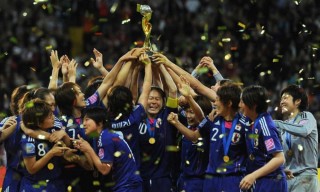Search
▼ The Rise And Stall Of Women’s Football In Japan
- Category:Event
Japan have played in the last two Women’s World Cup finals but the women’s game is still not fully embraced at home
By Philip Patrick for When Saturday Comes
England and Scotland are not the only sides worth watching in Group D at the Women’s World Cup. Japan, who kick off their tournament against Argentina in Paris on Monday evening, have played in the last two finals.
The team are nicknamed “Nadeshiko” after a lacy, pink carnation that is found in the mountains of Japan and came to suggest an idealised vision of Japanese womanhood, suffering silently and gracefully in the cause of the nation. Although, the team’s success has given that word a new meaning.
Japan reached the last Women’s World Cup final in 2015, which they lost 5-2 to USA, but their finest hour came four years earlier against the same opponents in Frankfurt. Japan had not beaten USA in their previous 25 attempts before that final but, after a 2-2 draw, they defied all the odds and won the World Cup in a penalty shootout.
That victory came just four months after the earthquake and tsunami that devastated the Tohoku region and claimed 20,000 lives. No sporting story, however remarkable, could ever offset such a tragedy, but it was undeniably a welcome relief to a traumatised country.
I remember watching the game in Tokyo with a feeling of mounting disbelief – partly that the Japanese were somehow hanging in there against players who looked twice the size of their opposite number but also because the Japanese broadcaster NHK had chosen to superimpose a figure 7 on to a quarter of the screen to remind viewers that there was just one week left before the analog to digital changeover. It was there, obscuring the action, for the entire game.
The broadcaster’s insult betrayed a deep-rooted condescension towards the women’s game in Japan, a feeling that women’s football wasn’t real football. In the early 1980s women’s tournaments even had different rules: the pitch was smaller; they played with a special “girls’ ball”; the halves were only 25 minutes long; and hands were permitted if they were used to protect chests.
Things improved somewhat after the formation of the first women’s league in 1989, which enjoyed success in the boom years of the early 1990s. But as the decade came to a close, the economy contracted and the nascent league withered. Things got so bad that some clubs stopped charging for admission and games were even played on public fields.
The World Cup winners of 2011 emerged from this environment. Many started their football careers in boys’ teams as there was no organised school football for girls. The bulk of the players were essentially amateurs who trained after putting in shifts at part-time jobs.
Winning the World Cup did make a difference, of sorts. In the immediate aftermath of the final in 2011 many players won sponsorship deals and participation at universities boomed. But it didn’t last long. With salaries still paltry compared to the men, few players chose professional football as a career and many of those who did quit after a few years.
The absence of sustained growth and failure to capitalise on the team’s success has been blamed on the Japanese Football Association, which still lacks faith in the long-term potential of the women’s game. The current league has two divisions, but most players remain part-time and many still drop out after a couple of years. Only a few clubs have permanent grounds. Reigning J-League champions, Beleza, from Tokyo, played “home” games in multiple stadiums last year. Attendances of over a thousand are rare and only the national team’s games are broadcast on mainstream television.
There is room for optimism, though. The fundamentals of the women’s game are strong and some suggest that its tight-knit, small-scale nature is its greatest asset. Most players come their clubs’ local area and there is less of a barrier between the team and fans, with players mingling with supporters before games. There may not be much money around, or support from above, but there is a close connection to the local community that the grander, glitzier men’s clubs have long since lost.
Social media enables fans to keep in touch and up to date, while online streaming bypasses the major networks and provides access for the less fashionable clubs. The online streaming service MyCujoo will soon begin covering the second division, which should allow for steady growth. And further progress could be made if Japan is successful in its bid to host the 2023 Women’s World Cup.
The real legacy of 2011 may have been a change of perception and far greater respect. The Nadeshiko label has endured, but the meaning has shifted – it’s now a byword for brave, determined battlers, rather than fragile mountain blooms. The national team has a female coach and the stars of the 2011 team – such as Homare Sawa, the former Fifa World Player of the Year – are respected TV commentators who cover the men’s game as well as the women’s.
Though not among the favourites this summer, Asako Takakura’s team are Asian champions and they tend to thrive as underdogs. Several of the 2011 legends are still in the squad and the spirit of that never-to-be-forgotten day in Frankfurt is very much alive. Don’t rule out another (minor) miracle this summer.
- June 11, 2019
- Comment (0)
- Trackback(0)


